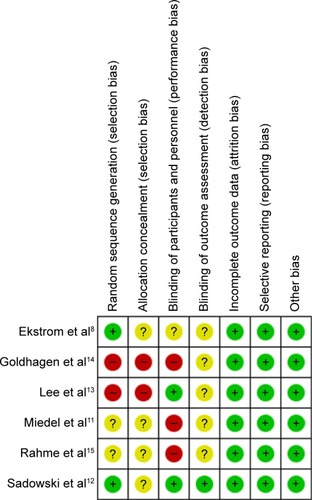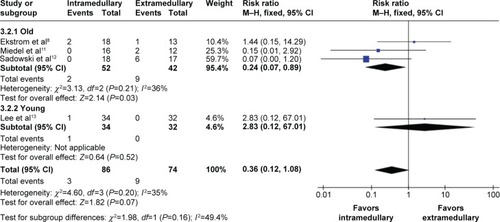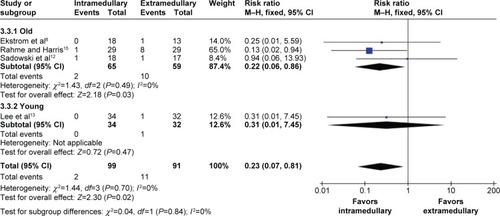Figures & data
Table 1 Summary of demographic data for eligible studies
Figure 1 The selection of randomized controlled trials (RCTs) comparing intramedullary with extramedullary fixation for subtrochanteric fractures in adults is shown.

Figure 2 Risk of bias summary: review of authors’ judgments of each risk of bias item for each included study.

Table 2 Meta-analysis of the outcomes of interest
Figure 3 The forest plot compares two RCTs that included 93 elderly patients for the revision rate.
Notes: The 95% CI of the pooled RR is 0.05–0.60. It showed that there was also a lower risk of revision rate for elderly patients with intramedullary fixation.
Abbreviations: RCTs, randomized controlled trials; M–H, Mantzel–Haenzel method; df, degrees of freedom; CI, confidence interval; RR, relative risk.

Figure 4 This forest plot shows the RR of fixation failure rate in four studies comparing intramedullary and extramedullary fixation, stratified by patient age.
Notes: The diamonds indicate the 95% CI of the subgroup and the overall pooled estimate. It showed there was a significant lower risk of fixation failure rate for elderly patients with intramedullary fixation.
Abbreviations: M–H, Mantzel–Haenzel method; df, degrees of freedom; CI, confidence interval; RR, relative risk.

Figure 5 This forest plot shows the RR of non-union rate in four studies comparing intramedullary and extramedullary fixation, stratified by patient age.
Abbreviations: M–H, Mantzel–Haenzel method; df, degrees of freedom; CI, confidence interval; RR, relative risk.

Figure 6 This funnel plot of four RCTs with 191 patients for wound infection shows no evidence of asymmetry, which suggests that there was no statistically significant publication bias. Data from Miedel et al,Citation11 Sadowski et al,Citation12 Lee et al,Citation13 and Rahme and Harris.Citation15

